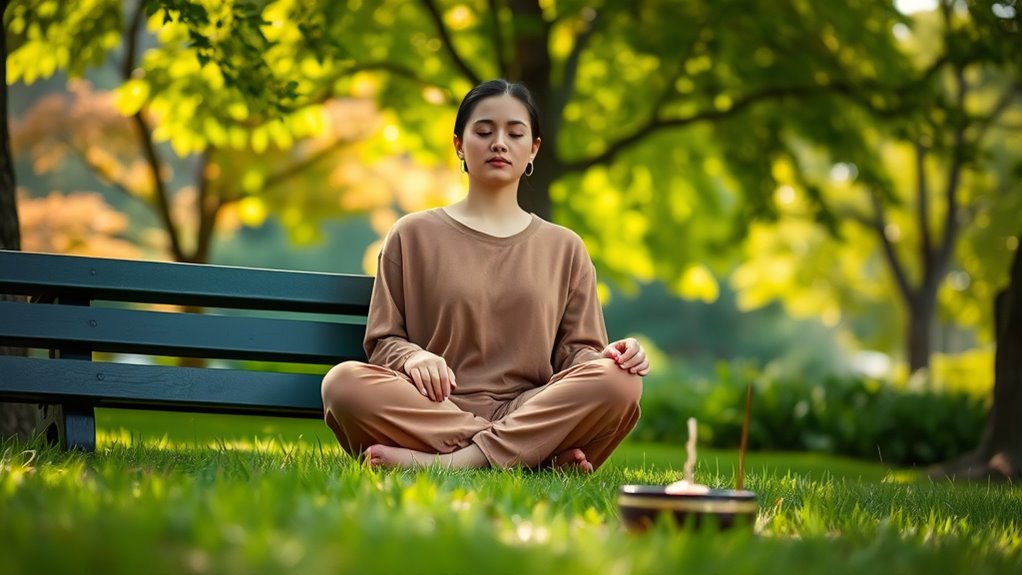To relieve daily stress, try simple mindfulness techniques like breathing exercises and body scans. Sit comfortably and focus on slow, deep breaths to calm your nervous system and reduce tension. You can also do a body scan by paying attention to each part of your body, releasing any tightness you notice. Consistent practice helps you stay more grounded, relaxed, and resilient through busy days. Keep exploring these techniques to discover even more ways to find calm when it’s needed most.
Key Takeaways
- Incorporate simple breathing exercises, focusing on slow inhales and gentle exhales to quickly calm the nervous system.
- Practice body scans regularly to increase awareness of tension and promote physical relaxation.
- Use mindfulness techniques during stressful moments to ground yourself and prevent spiraling worries.
- Dedicate a few minutes daily to focused breathing or body scans for long-term stress resilience.
- Combine breathing and body scan practices for comprehensive stress relief and improved mental clarity.

Have you ever wondered how to reduce stress and improve your mental clarity? If so, you’re not alone. Daily life can be overwhelming, but simple mindfulness techniques can make a big difference. Two effective methods you can try are breathing exercises and the body scan. These practices are easy to incorporate into your routine and can provide immediate relief from tension and anxiety.
Start with breathing exercises. They are straightforward but powerful tools for calming your mind and body. Find a quiet space, sit comfortably, and focus on your breath. Inhale slowly through your nose, filling your lungs completely, then exhale gently through your mouth. Pay attention to the sensation of the air entering and leaving your body. If your mind wanders, gently bring your focus back to your breath. This simple act helps regulate your nervous system, reduces cortisol levels, and creates a sense of calm. Breathing exercises can be practiced anywhere—at your desk, in your car, or before bed—to help manage stress throughout the day. The key is consistency; even a few minutes of focused breathing can shift your mental state from overwhelmed to centered. Incorporating mindfulness into your daily routine can also improve your overall emotional well-being and resilience.
Start with simple breathing exercises to calm your mind and body anytime, anywhere.
Next, try a body scan. This mindfulness technique involves systematically paying attention to different parts of your body, observing sensations without judgment. Lie down or sit comfortably, close your eyes if you like, and take a few deep breaths to settle in. Start by focusing on your toes, noticing any tension, warmth, or tingling. Slowly move your attention upward, to your calves, knees, thighs, and so on, all the way up to your head. As you do this, acknowledge each sensation without trying to change it. This process helps you become more aware of physical tension that may be contributing to your stress. It also encourages relaxation, as you consciously release any tightness you encounter. The body scan is especially effective at grounding you in the present moment, preventing your mind from spiraling into worries about the past or future. Regular practice of this technique can enhance your ability to stay mindful and present throughout the day.
Frequently Asked Questions
Can Mindfulness Techniques Replace Professional Therapy?
Mindfulness techniques can’t fully replace professional therapy because of their limitations, especially for serious mental health issues. While mindfulness offers effective therapy alternatives for managing daily stress and improving well-being, it may not address underlying conditions like depression or trauma. You should consider therapy when your stress or emotional challenges are severe or persistent, as a trained therapist provides personalized support and guidance that mindfulness alone can’t offer.
How Long Should I Practice Mindfulness Daily?
You should aim to practice mindfulness for about 10 to 20 minutes daily. Incorporate this practice into your daily routine at a consistent time, like mornings or evenings, to build a habit. The practice duration can vary based on your comfort and schedule, but regular, focused sessions help reduce stress effectively. Start small, and gradually increase your practice duration as you become more comfortable with mindfulness.
Are There Any Risks or Side Effects?
You might think mindfulness has no risks, but mindfulness misconceptions can lead to potential drawbacks like increased anxiety or emotional discomfort if practiced improperly. It’s important to approach mindfulness with awareness and proper guidance, especially if you have mental health concerns. While generally safe, some people may experience temporary feelings of frustration or unease. Always listen to your body and consult a professional if you notice negative effects.
Can Children Benefit From Mindfulness?
Yes, children can benefit from mindfulness, especially when managing child anxiety and improving emotional regulation. You can teach them simple breathing exercises, guided imagery, and mindful listening activities. These techniques help children stay present, reduce stress, and develop resilience. By practicing mindfulness regularly, you foster emotional awareness, ease anxiety, and promote overall well-being—building a foundation for healthier emotional responses now and in the future.
What if My Mind Keeps Wandering During Practice?
If your mind keeps wandering during practice, don’t worry—distraction management is key. Gently bring your focus back to your breath or chosen point without judgment. Over time, this enhances focus and attention. Remember, wandering minds are normal; patience and consistency help strengthen your ability to stay present. With practice, you’ll notice improved focus and better stress relief, making mindfulness a more effective and calming daily habit.
Conclusion
By practicing these mindfulness techniques daily, you plant seeds of calm that grow into a peaceful garden within you. Remember, each moment of awareness is like a gentle ripple on a still pond, soothing your stress and restoring your balance. When life feels overwhelming, pause, breathe, and reconnect with the present. Over time, you’ll find your inner calm blossoms, turning chaos into harmony and turning your mind into a sanctuary of serenity.









